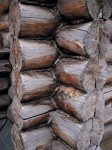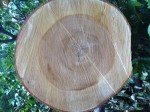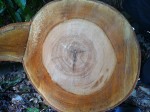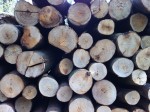Although still unfinished, this article is being posted because we felt is still contains very useful information. This article is still considered a draft, but hopefully you can get some good info from it until we have time to boil it down and finish. – EWC
—-
The short “to do” for maintaining a solid-body dummy: First, we recommend adding 3-4 layers of polyurethane to the new dummy (inside and out). This makes it harder for moisture to get in and out. (wax, oil, and grease, are all okay alternatives). Second, buy a hygrometer and keep the humidity levels over 45% in the room that the dummy is in and do NOT let the humidity level in that room change much. Keep the dummy out of drafts (esp from windows or heating vents) or direct sunlight and away from heaters or air conditioners (blowing air dries the wood out fast). It is ideal to keep the dummy in 50-60% humidity (i.e. normal humidity), but know that is not always possible. If you start seeing checking in your dummy you need to try to stop the moisture from leaving the dummy so quickly 1) reduce temperature if possible 2) seal the dummy and cracks the grease or oils, 2-part epoxy glue 3) raise the humidity in the room ASAP 4) get the dummy out of a draft (cover it). If left unattended the dummy will end up cracking.
[11 May 2016] – Quick note: Here is a report a customer sent us by Dian-Qing Yang and Danny Normand on the best-practices-to-avoid-hardwood-checking-part-I. It might be worth a read if you find this interesting – it covers a lot of the same info we have below from a more scientific background.
—-
Now for more details:
Buick Yip has been making solid log dummies since about 2002 or so. We’ve sold his dummies on Everything Wing Chun since 2005. Buick’s dummies were relatively unknown to the larger Wing Chun community at that time – but thanks to the work of Everything Wing Chun and Buick’s commitment to quality, his dummies have now become some of the most famous in the world.
This post will attempt to cover some basic information on solid body dummies, like Buick’s, and give you our thoughts on the correct humidity levels to keep a dummy and any WHY we think the way we do.
There has always been some misunderstandings about solid log dummies on the part of customers, who expect the wood to act like a cheaper laminate dummy. The laminate dummies are made from glued boards that are usually kiln dried and from the outside rings of a tree. A tree, however, has 2 types of cells – the ones on the outside that hold the tree up, and the ones in the center that pass nutrients up. Solid log, or “solid body”, means that the trunk of the dummy is made from a solid log – it is one piece from the core of a tree… So it has both type cells – and they act differently in different circumstances.
Solid body dummies are really the most beautiful and most traditional kind of dummy you can own. But just like a high-end katana that one must keep oiled (as opposed to your common butter knife), high-end dummies require more care, not less. The risk with these solid dummies is that whenever they change climates or humidity there is the chance of the dummy body cracking. If you are going to drop $1500-$3000 on a Buick dummy, you need to know how any why this happens and be prepared for it – or else you can’t prevent it.
In Part 1 I will attempt to give you an overview of why solid logs crack (it’s called “Checking” in the industry). In Part 2 I will detail some of my own semi-scientific testing on about $10,000 worth of Buick’s dummies. In Part 3 I will tell you what I think the ideal humidity levels for Buick’s dummies are and why.
Background:
I started researching this a few years ago, after we had a particularly bad batch of dummies the cracked quite badly upon arrival to N. America. We had always know some customers get dummies that cracked (about 10% or so). And for the longest time that blame (rightly or wrongly) went to Buick – and to us for selling his dummies. We were acting as an advocate for our customers and Buick was replacing these dummies, but telling us privately that it was really the customer’s fault for not caring for the dummy. This is when Buick started telling customers to grease the dummy and let it sit upon arrival and air out. And to grease it when not in use. (He was on the right track we now know, but that is quite messy!)
We at EWC were fairly neutral and have dropped vendors for less, but wanting this venture to succeed we also spend time researching better ways to dry solid logs and having Buick do the same. Our thought was that it was simply the drying process that was the issue. Buick made wonderful strides in this area over the next 2 years and we became pretty confident the dummies were indeed being dried.
However we starting seeing things that did not make sense – such as extremely dried logs cracking within weeks of reaching a customer, and also dummies that were fine for 8 months in a customer’s home and then suddenly crack badly in 2 weeks. At that point we started better researching the conditions the dummies were kept in. It was/is a long and hard process because the customers had no real data to give us (usually no clue as to the humidity) and almost all the evidence was circumstantial. Around this time (2010) we put out a short .pdf on the care of Buick’s dummies and warnings on the site saying things like: keep humidity constant, no de-humidifiers, careful of A/C and heaters, etc… We were on the right track, but we still lacked any real scientific data (for example what humidity level did the cracking start to occur in each wood? What was the moisture content of a dummy at any humidity level?).
Now finally in 2012 we were able to make some real headway. We also have come to the conclusion that cracking (“checking” as it is know in the industry) is also a well know issue that is thought to be natural in any solid log and not a big deal. Actually the more we researched the more we realized Buick was actually doing a pretty damn good job of preventing checking in the dummies.
So here we are… and this is what we have found so far:
Part 1 – Solid Logs, Checking (cracking), Humidity and more
This quick article re-posted here will give you a bit of the science behind why solid logs are different that your typical future wood (they have 2 cell types – the outer core for stability and the inner core fore passing nutrients up):
Cracking Logs and Warped Boards
Alaska Science Forum
April 4, 1988
Article #867, by Sue Ann Bowling
This article is provided as a public service by the Geophysical Institute, University of Alaska Fairbanks, in cooperation with the UAF research community. Dr. Sue Ann Bowling is an Associate Professor of Physics at the Institute.
 “Radial cracks in logs, clearly displayed in this corner of a log building, are an inevitable result of drying. They represent the only way a large whole log can manage to shrink more in circumference than radially.
“Radial cracks in logs, clearly displayed in this corner of a log building, are an inevitable result of drying. They represent the only way a large whole log can manage to shrink more in circumference than radially.
Logs crack, most often in long spirals. Boards curl. Doors stick in damp weather, and chairs pull apart when it’s dry. Wood is a marvelous material in many ways, but it does have its problems under changing humidity conditions.
The original function of wood, of course, was to hold up trees, not houses. Wood that is supporting a living, healthy tree is not subject to large, uncontrolled humidity changes. The inner part of the trunk is shielded from fluctuations by the outer part, which is carrying moisture between the leaves and the roots of the tree. Food travels in the living phloem tissue just under the bark. Water and minerals are carried through the xylem, the living but no longer growing outer part of the woody trunk.
When the tree dies or is cut, it dries until its moisture content is in balance with the humidity of the surrounding air. As water is removed from the xylem tissue, it shrinks. But the shrinkage is not uniform. The cells of the xylem have the dual job of transporting fluids along the tree and resisting bending. Understandably, the structure and consequently the amount of shrinkage differ in the direction up and down along the tree trunk, the radial direction (from the center to the bark), and the tangential direction (around the tree). Furthermore, unless the drying is carefully controlled, the outer part of the wood will dry faster than the inside. All of this puts stresses on the drying wood.
Shrinkage along the grain of the wood is very slight — generally less than a tenth of a percent. Tangential and radial shrinkages are much larger. Worse, they are often quite different. In a spruce log, for instance, the radial shrinkage on complete drying is about three percent, while the tangential shrinkage is more than twice that much. The circumference of a circle is an exact multiple of its radius, so if the fractional shrinkage of the circumference is more than that of the radius, something gives, and the circumference develops gaps. If we apply this to house logs, where the situation is made worse by the outside of the log drying faster than the inside, the result is cracks.
Cut boards have slightly different problems. A board which is cut so that the growth rings, looked at from the end of the board, show as little curvature as possible is unlikely to warp if the drying process is properly controlled. However, if a board is cut nearly parallel to the bark, so that the growth rings appear to curve on the board end, the differential shrinkage on drying will have the same effect as if the growth rings were shrinking rubber bands. The growth rings will try to straighten out, and the board will tend to curl in the opposite direction from the curve of the growth rings. Knots will also cause problems, as their diameters will shrink more than will the surrounding wood, which is oriented so that shrinkage is in the tangential and lengthwise directions.
Regardless of how well the wood is cut, lumber will expand and contract to some extent as the humidity changes. A wooden door that is properly fitted in low humidity will expand and stick in very wet weather. If it is properly fitted in wet weather, it may develop gaps when the weather is very dry. Furniture to be used in an area where the indoor climate is dry should be assembled under similarly dry conditions, or joints may loosen in use.”
Okay – so 1) the log will always dry to match the surrounding air 2) the log cracks due to the outside of the trunk drying faster than the inside and the stress of the outside shrinking and the inside not shrinking at the same rate causes the different grains to pull apart. Got it?
Here are a few quotes from makers of fine log homes and furniture:
“There is a vast difference between fine furniture, mass manufactured furniture and log furniture as it ages. All log furniture is subject to the natural process of “checking”. Checking, or log cracking, happens as wood releases moisture, and normally occurs across, or through, the tree’s annual growth rings. It is the usual result of wood seasoning.
Checking occurs mainly on the surface of solid log wood. This natural process does not affect the structural performance or integrity of the wood. This only adds to the unique character and rustic appeal of each piece. Without a doubt, this individuality and relaxed personality is what makes log furniture so popular. The degree of checking will vary from product to product and from log to log.
Unlike glued together fine furniture, checking and knots are expected with log furniture. Checking can range from very slight slivers to cracks running the full length of the log to the heart or middle of the log wood. In either case this checking is completely normal and in no way affects the integrity of the wood, or the strength of your new furniture. The unique nature of each individual log acts to accentuate it’s charm, add character and further the natural appeal and rustic qualities. There are times when molded to perfect proportions and a mass production replication of every conceivable surface just isn’t what we seek. Log furniture and rustic decor fill this void so highly sought in today’s increasingly hectic and overly commercialized world.”
Okay – so these guys say it is normal and part of the charm of furniture (we can agree there), but a “rustic dummy” is not really what we want. However, is it really normal on all logs? If we look at any maker of log homes or log furniture, they seem to think so:
“Checks are naturally occurring lengthwise separations between wood fibers. As your logs dry – moving from fiber saturation point to equilibrium moisture content – it is natural that checks will appear. In fact, if you look at the logs used in most model and show homes, you will notice these checks yourself.”
Hmmmm.
“We’ve all seen the tiny cracks in telephone polls, log homes, and even log furniture. These cracks are known as checks and naturally occur in round logs. While checks are common in round logs, there are a few things you should know about them as a log homeowner.
Checking occurs as the logs dry and shrink. Because logs dry from the outside in, the log is shrinking at different rates. This puts pressure or stress on the log, causing it to check or pull apart slightly….”
Okay – so this issue is the rate of drying – the outer core of the wood dries faster than the inner core and the grains pull apart. Furniture makes and even log home owners are cool with it. It does not affect integrity of the log and really, unless water or bugs get in the cracks it is pretty much okay by them.
But the problem is that Buick has been drying the dummies well. We visited the workshop, we have researched up to date drying methods and seen them implemented by Buick. So what gives?
Well, the problem, we’ve found out is that wood will always adjust its moisture content to the humidity in the surrounding air (paint and polyutathaine only help to slow the process)…
Actually this article is starting to run long, so I’m going to skip on much of the rest of the research. I’m not a wood expert, but I have now ready dozens of the best research articles I can find on these topics. If you want to verify what I say here, you can do the research on your own – but please let me know if you find something contradictory… Start with Wikipedia:
“Equilibrium moisture content
Main article: Equilibrium moisture content
Wood is a hygroscopic substance. It has the ability to take in or give off moisture in the form of vapour. Water contained in wood exerts vapour pressure of its own, which is determined by the maximum size of the capillaries filled with water at any time. If water vapour pressure in the ambient space is lower than vapour pressure within wood, desorption takes place. The largest-sized capillaries, which are full of water at the time, empty first. Vapour pressure within the wood falls as water is successively contained in smaller capillaries. A stage is eventually reached when vapour pressure within the wood equals vapour pressure in the ambient space above the wood, and further desorption ceases. The amount of moisture that remains in the wood at this stage is in equilibrium with water vapour pressure in the ambient space, and is termed the equilibrium moisture content or EMC (Siau, 1984). Because of its hygroscopicity, wood tends to reach a moisture content that is in equilibrium with the relative humidity and temperature of the surrounding air. The EMC of wood varies with the ambient relative humidity (a function of temperature) significantly, to a lesser degree with the temperature. Siau (1984) reported that the EMC also varies very slightly with species, mechanical stress, drying history of wood, density, extractives content and the direction of sorption in which the moisture change takes place (i.e. adsorption or desorption).”
To start to boil this down – if the dummy equalizes its moisture content at one level of humidity, then the the humidity suddenly drops, the outer core of the wood will shed it’s water quickly, the inside will not, and checking in the log will occur. If you leave it outside in humid conditions, then bring it in to a house with air conditioning, the humidity might be 30% lower, or more – and the dummy can crack over the next week. If you crank the heat up in winter – the air can dry out, humidity drastically drop and you will risk cracking. With a solid body dummy you will always have to keep an eye on the humidity.
Paint and varnish will help slow this expansion and contraction process from happening, but it still happens. This can been seen in many houses as well – painted boards will swell or shrink throughout the year making doors stick, decks warp, and the like. And while modern construction can take a lot of these factors into account and use proper spacing to prevent the swelling/shrinking from affecting the house too much a solid log does not have that capability. If it loses water too fast it will crack.
Part 2 – Semi-Scientific Testing
In order to better serve customers we are now going to test the humidity levels commonly seen in North America and Europe on Buick’s dummies so we can get a better idea of the proper range that a dummy can be in without cracking. This is a costly experiment due to the fact we are using a $2500 Teak, $2200 Tiger Marble, and a $2000 Mahogany dummy for the testing.
As a reminder, I am not a wood expert –  I have read tons on the internet about cracking, prevention, and the like – simply due to necessity, but have no real training in this area. Also, it is quite hard to do any real scientific testing on a solid body dummy. The instruments that measure water content (WC) don’t penetrate far enough into a dummy to give an accurate reading (not to mention the outer core and inner core might be different readings). There is also the issue that each type of wood reads differently. We also can’t throw a dummy in an oven and bake all the moisture out to see how much water it had left (that would ruin the dummy, not to mention you need a big oven!). So we have to rely on mathematical calculations and charts we’ve found from good woodworking sources to determine moisture content.
I have read tons on the internet about cracking, prevention, and the like – simply due to necessity, but have no real training in this area. Also, it is quite hard to do any real scientific testing on a solid body dummy. The instruments that measure water content (WC) don’t penetrate far enough into a dummy to give an accurate reading (not to mention the outer core and inner core might be different readings). There is also the issue that each type of wood reads differently. We also can’t throw a dummy in an oven and bake all the moisture out to see how much water it had left (that would ruin the dummy, not to mention you need a big oven!). So we have to rely on mathematical calculations and charts we’ve found from good woodworking sources to determine moisture content.
Our base assumptions from our research was that the moisture content in Buick’s dummies are about at most 14%. This is mainly due to the fact we felt even after drying the dummy might re-absorb moisture from the surrounding air. This would be an okay moisture content for average humidity in most of the USA. We’d probably need to see a moisture content of 5% for low humidity areas and 0-3% for arid environments. Keep in mind the less water content a dummy has the lighter it will be and the easier to break it will be. The wood needs some moisture to be strong and resilient – 2 good qualities in wooden dummies. I’ve seen a 120lb marble dummy lose over 40 lbs of water… and it went from super solid to almost brittle. (picture how easy it is to break a dried stick vs. a greener one). Green wood is not good, but neither is brittle wood.
So, how are we going about testing? Well, not in the most scientific way, but it should give us some good data. Dummies typically crack within 2 weeks on being moved to a new environment, so that is out testing time frame for each scenario.
First we are using dummies here in the US during the winter. They have been in the USA in an unheated environment where the temperature goes from about 30-60 degrees and the humidity level is about 40-60% depending on the day. They have been stable for about a month. BTW, our warehouse is about 50 degrees Fahrenheit in the winter with a humidity of about 50%. We’ve never had a single dummy crack in the warehouse.
On a side note temperature does not really affect cracking as far as we can tell. I’ve been told the water in the wood can’t freeze because it is chemically bound. All temperature does is affect the rate at which the water comes into or leaves the dummy – so how fast the dummy’s moisture content equalizes with the surrounding air’s humidity. Therefore are assuming that a colder temperature is actually better for a dummy moving into a more arid environment since the water will leave the dummy at a slower rate and thus there is less of a change of cracking occurring.
So now we set each dummy up, and get a humidity and temp reading. They are first setup in a home garage (where many people install a dummy) that is unheated. The temperature range is currently 45-65 degrees Fahrenheit and the humidity approx 40% (outside it is ranging from 50-75% weekly). The dummies had no issues.
—–
After 2 weeks we moved the dummies indoors where the humidity range is 24-30%, but the temperature is 67-72 degrees F. We moved the teak in 3 days before the mahogany and tiger marble.
On approx day 8 the teak started checking top to bottom from a small hairline crack that was already present at the top of the dummy. The crack is only a hairline crack about the size of the edge of a piece of paper and it is sort of hard to see due to the grains, but very obvious to me since I have been watching these daily. I immediately moved the teak back outside the to 60 degree, 40% humidity level. On day 5 for the tiger and mahogany dummies I saw the marble develop a small new hairline crack, so I immediately moved it and the mahogany to the outside as well. Today I will get more grease to seal the dummies better as well as putting spray varnish on the inside of the arm and leg and slat holes.
—–
The grease and colder temp worked. It has been a week and a half and nothing has chanced on the dummies. Temp range from freezing to 68 degrees. Humidity from 40-57%.
—–
After two and a half weeks I marked every little slit, crack, or hint of a crack on each dummy. with a marker I made fine points on each end of any existing crack. It is the only way we can tell if they grow or not. I then moved them into a 65 degree room with a 35-50% humidity indoors. The humidity range is due to the fact the AC/Heater runs some days and not others. This is a typical N. American house – which is what we wanted to test in. The humidity was under 40% most of the time. After one week I see no change in the teak or mahogany. The tiger marble is showing signs of cracks lengthening.
—–
Part 3 – So far:
I would put around 40% as the cutoff for the humidity level. Anything under that and we see signs of stress in the dummies, especially at warmer temps. At the 40-45% humidity in 60 degree weather they all held strong. Average humidity and what is considered most healthy for humans is 50-60%. Over 60% you can get mold in some areas. 80% is high humidity. 30% is considered Arid. If you run the A/C or heat a lot you might drop your house into the 30-40% range or lower, so be forewarned – it is bad for the dummy (and you).
So, once again, the short “to do” for maintaining a solid-body dummy: First, we recommend adding 3-4 layers of polyurethane to the new dummy (inside and out). This makes it harder for moisture to get in and out. (wax, oil, and grease, are all okay alternatives). Second, buy a hygrometer and keep the humidity levels over 45% in the room that the dummy is in and do NOT let the humidity level in that room change much. Keep the dummy out of drafts (esp from windows or heating vents) or direct sunlight and away from heaters or air conditioners (blowing air dries the wood out fast). It is ideal to keep the dummy in 50-60% humidity (i.e. normal humidity), but know that is not always possible. If you start seeing checking in your dummy you need to try to stop the moisture from leaving the dummy so quickly 1) reduce temperature if possible 2) seal the dummy and cracks the grease or oils, 2-part epoxy glue 3) raise the humidity in the room ASAP 4) get the dummy out of a draft (cover it). If left unattended the dummy will end up cracking.
Regarding a Buick dummy in the UK, a customer gave us the following information:
“Humidity in my house wouldn’t drop below 50% at any time and it vary from 50% to 75%. Most of the time is around 60. I tried to run central heating and it seems that if you run it for a couple of hours, humidity wouldn’t drop at all. In UK you wouldn’t run central heating for longer than 2-3 hours a day as we have mild winters.
What I’ve noticed is that humidity drops rapidly if you have windows open for longer especially when there is a draft (draught). Even if the humidity outdoor is high, it will drop inside a house quickly, in some days to 45%. That seems to be something people may need to be aware of.
I waxed the dummy twice using some quality bee wax. I think any teak oil or similar products wouldn’t penetrate the coating you apply on your dummies. I think wax may be the best solution as it creates some layer on a surface and it doesn’t attract dust.
In short words, in average UK house your dummies should be fine even if you run central heating form time to time. I would avoid any drafts for a longer period. Also, humidity seems to be higher just under a floor. If you place hygrometer at the top of a dummy it is usually lower. I would keep an eye on top parts of the dummy as it may dry a bit faster.”
Good advice. Thanks, M!
We are still testing… to be continued.
PS. Take a look at any solid logs or solid beams in a log cabin, cut trees in the woods, and older solid log furniture that has a lot of width and thickness – 9 times of of 10 there are large cracks running through the wood. Here are some examples:
Also, we should not that the logs Buick gets are not fresh and usually already have checking in them. Same with other dummy makers – and you can see the filled cracks on most dummies out there. Buick tends to be highly selective in the woods, but almost all still have hairline checking. That is quite normal for a starting place.
To be continued…








